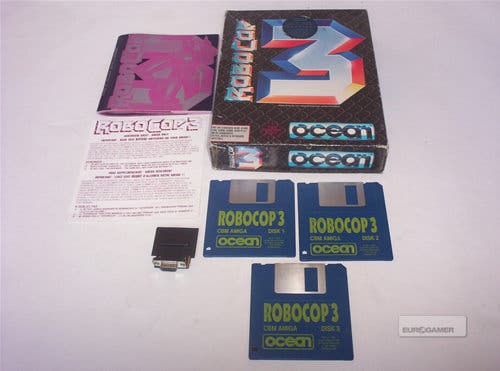Banging the DRM
The history of anti-piracy.
LucasArts tried to find ways around this by printing code sheets on dark paper, as with Maniac Mansion, or in ink that could only be seen through a special red filter. The Secret of Monkey Island came with a code wheel, made up of two interlocking circles that combined to form different pirate faces. This meant that anyone with a home copied version would at least have to invest in some scissors and a split pin to enjoy their dodgy copy. Increasingly for PC, Amiga and ST owners in the 1990s, evading copy protection meant using more craft materials than Blue Peter.
This was a time when computer games came in enormous shelf-hogging cardboard boxes, large enough to house a family of otters, and with only a few floppy discs and a manual rattling around inside, some publishers used the available space for collectible trinkets that doubled as anti-piracy measures.
Quite apart from the allure of owning pretend books, crystals and maps from the latest adventure game, these items could be used to catch pirated players out. Zork Zero, for example, boasted a calendar, blueprint and parchment. Information contained within was essential to completing a pivotal puzzle, with the game directing players to their game packaging for the solution. Those who were unable to comply were greeted with the pirate-baiting message, "Good luck, Blackbeard."

Such metatextual measures were less intrusive than the crude manual shuffling of other titles, but they were still easily beaten by a resourceful and determined copy-monkey, and also required a lot of fussing about for legitimate players. Finding non-software ways to defeat the pirates without hassling the player led Ocean, a company that had pioneered the use of speedloaders in the Spectrum era, to experiment with a famously unusual solution in 1992.
Released for the Amiga and Atari ST, Robocop 3 was already an oddball game, its early 3D polygon design marking a distinct change from the sprite-based side-scrollers that the licence-hungry Ocean specialised in. Making it even more notable was the addition of a plastic dongle, which sat in the primary joystick port. If the dongle wasn't present, the game refused to load.
In theory, it was a great idea and Ocean made a lot of pre-release noise about its effectiveness. Naturally, the pirates took the challenge and had a cracked dongle-free version available before the official street date. To make matters worse, the game came out shortly before Commodore released the Amiga 600, which shuffled the design of the Amiga 500 around so that the joystick ports were next to the floppy drive. The innuendo-laden result: Robocop's dongle didn't fit.
Posting on The Ocean Experience message boards in 2005, Ocean head honcho Gary Bracey explained that the aim wasn't to eradicate professional piracy, but to stem the tide of amateur pirates in those vital early weeks on sale.
